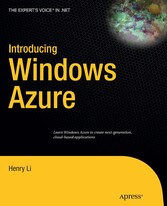Suchen und Finden
Dedication Page
4
Table of Contents
6
Foreword
11
About the Author
14
About the Technical Reviewer
15
Acknowledgments
16
Introduction
17
Windows Azure Essentials
17
Web Role
20
Worker Role
20
Azure Fabric
20
Who This Book Is For
21
Prerequisites
22
How This Book Is Structured
23
Chapter 1: Create Cloud Table Storage
23
Chapter 2: Access Cloud Table Storage
24
Chapter 3: Working with Cloud Queue and Blob Storage
24
Chapter 4: Windows Azure Application Integration Using WCF
24
Chapter 5: Windows Azure .NET Services—Access Control
24
Chapter 6: Windows Azure .NET Services—Service Bus
24
Chapter 7: Windows Azure .NET Services—Workflows
25
Chapter 8: SQL Azure
25
Chapter 9: Deploy Windows Azure Applications to Production
25
Appendix
25
Downloading the Code
25
Contacting the Author
26
Chapter 1 Create Cloud Table Storage
27
The Table Storage Specification
28
A Closer Look at Entities
29
Azure Development Storage
30
Create Cloud Data Storage with a Simple Data Structure
31
Using Portable Data Types for Data Columns
41
Using Data Tables Generated by Windows Azure Development Tool
41
Solutions to Non-Portable Data Types
41
Data Context Class Inheritance
43
Using PartitionKey and RowKey to Organize the Data to be Distributed
44
Create Cloud Data Storage with Relational Data Structure
45
A Constraint for Data Entity Classes Contains Embedded Entity Classes
47
Refactoring Data Entity Classes
48
Close SQL Analysis
49
Summary
49
Chapter 2Access Cloud Table Storage
50
Accessing a Single Cloud Data Storage Table
50
Data Entity Class Constructors
66
Table Storage Keys
67
Log Runtime Message and Event Information for Debugging
67
Leverage the Power of Development Fabric Services
68
Using Fiddler 2 to Debug Cloud Storage Applications
68
Leverage LINQ to Query Entities in Cloud Storage
70
Using HTTP REST to Query the Top N Entities
71
Using Continuation Tokens to Retrieve Paginated Data
71
Deleting and Updating an Entity in a Single Cloud Data Storage Table
73
Update Data Tables in Buckets
84
Best Practices in Using the DataServiceContext Object
85
Handling Relational Cloud Data Storage Tables
85
Summary
90
Chaper 3Working with Cloud Queue and Blob Storage
91
Azure Queue
91
Azure Blob Storage
93
Creating a Cloud Queue
94
Add a Worker Role in the Cloud Service Solution
94
Create a Queue Storage Container and Create a Named Queuefrom the Start Handler of the Worker Role
95
Create the Queue Using Account Information from the Configuration File
96
Create the Queue Programatically
98
Put a Message into the Queue
98
Poll and Delete a Message from the Queue
100
Delete a Message from the Queue
102
Parse a Message Received from the Queue
102
Query a Queue Using HTTP REST
104
Creating Cloud Blob Storage
104
Creating a Loosely Coupled Event-Driven System
113
Implementing a Client Application to Access Cloud Blob Storage
120
Summary
135
Chapter 4Windows Azure Application Integration Using WCF
136
Using WCF
137
Host WCF Service from Azure
137
Verify HostWCFService from the Local Development Environment
150
Summary
151
Chapter 5Azure .NET Services—Access Control
152
Working with the .NET Access Control Service
152
Build Your First Cloud Application Using the .NET Access Control Service
154
CardSpace .Net Access Control Services
164
AzureForDotNetDeveloperWCFserviceLibrary
164
Service Implementations and Configurations
166
Client Implementations and Configurations
168
Test Results for What We Have Built
170
Authentication Using X.509 Certification or CardSpace in .NET Access Control Service
171
Installing the X.509 Certificate
171
Associating the Certificate to the Azure Application URL
175
Using CardSpace in the .NET Access Control Service
177
Summary
193
Chaprter 6Azure .NET Services— Service Bus
194
Connecting to Remote Applications with the Service Bus
194
Service Name Hierarchy System
196
Service Registry and Publishing
196
Endpoint Relay Connectivity
196
Using WCF with the Service Bus
196
Post a Net Event Using Relay Connection
198
Simple Direct Connected System Using Hybrid Relay Connection Mode
207
Using .NET Service Bus to Build a Distributed Connected Windows Application
214
SoftnetSolutions.IShape
215
SoftnetSolutions.Shape
215
SoftnetSolutions.RelayService.ServiceContract
218
SoftnetSolutions.Shape.Draw
219
SoftnetSolutions.RelayService.ShapeController
221
Port Forwarding
223
Change Credential Type
225
.NET Service Bus Queue Client Facade
227
Summary
232
Chapter 7Azure .NET Services—Workflows
233
Hosting a Workflow Service in an Azure Cloud Environment
234
Coordinating WF Services Using HttpWebRequest
243
Summary
264
Chapter 8SQL Azure
265
Create a Virtual Server for SQL Azure
266
Connect to a SQL Azure Database Using SQL Server Management Studio
267
Create a Data Table Using SQL Server Management Studio
270
Simple Benchmark Testing Results
271
Verifying That SQL Azure Supports Relational Data Tables
273
Connect to a SQL Azure Database Using ADO.NET
277
Migrate Existing Databases from an On-Premises System to SQL Azure
278
SQL Azure Application Developing Tool: SQLAzureConnect
282
Functions of SQLAzureConnect
283
Using XML Data to Define UI Components Dynamically
285
SQLDataAccessComponent Class
288
SQLDataAccessHelper Class
293
Component Design and Implementation
304
ParameterControl
305
SQLDataServiceControl
308
FormSQLAzureConnect
316
Summary
318
Chapter 9Deploy Applications and Production Maintenance
319
Preparing the Application Package and Configuration Package for Deployment
319
Deploying Table Storage
321
Host an Application from the Cloud
324
Deploying Cloud Applications
325
Staging Deployment
327
Select the Application Package and Configuration Package
328
Running a Hosted Application
329
Maintenance of a Cloud Application
331
Increase or Decrease the Number of Instances
332
Override the Configuration
333
Redeploy an Application with a New Version
333
Summary
333
Azure Service Management Tools
335
Appendix
334
Index
336
Alle Preise verstehen sich inklusive der gesetzlichen MwSt.




















